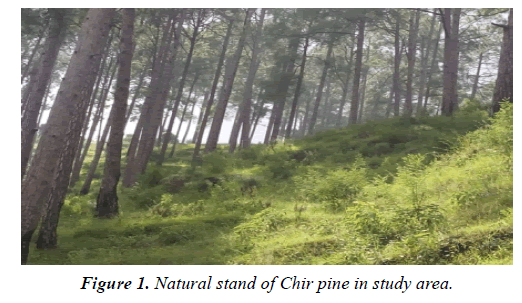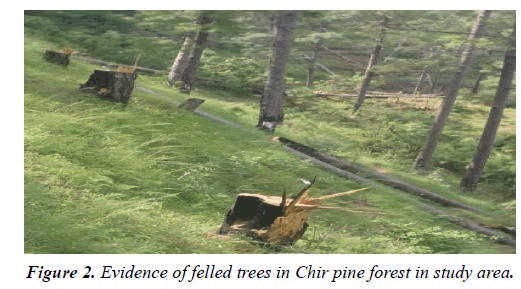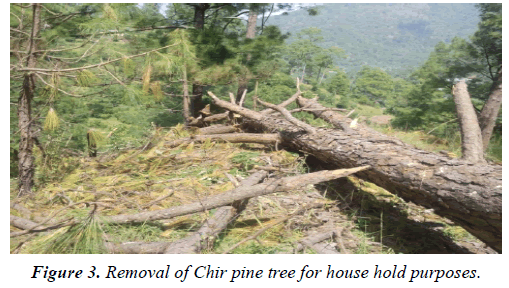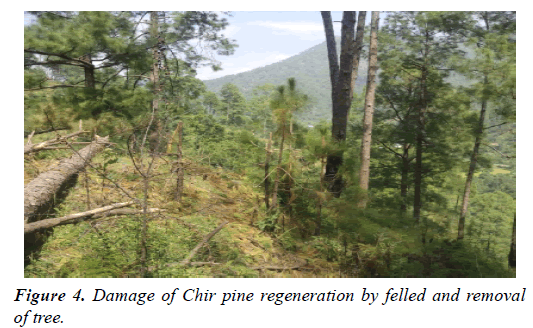Short Communication - Environmental Risk Assessment and Remediation (2017) Volume 1, Issue 1
Carbon stock loss of Chir pine forest through tree felling in Lower Himalaya.
Munesh Kumar1* and Rajiv Pandey2
1Department of Forestry, HNB Garhwal University, Srinagar- Garhwal, Uttarakhand, India
2Biodiversity and Climate Change Division, ICFRE, Dehradun
- *Corresponding Author:
- Munesh Kumar
Department of Forestry
HNB Garhwal University
Srinagar- Garhwal, Uttarakhand
India
E-mail: muneshmzu@yahoo.com; rajivfri@yahoo.com
Accepted date: November 29, 2016
Abstract
The Fifth Assessment Report of the Intergovernmental Panel on Climate Change (IPCC) indicates that Agriculture, Forestry, and Other Land Use (AFOLU) sector accounts a quarter (10- 12 GtCO2eq/yr) of anthropogenic GHG emissions mainly from deforestation and agricultural emissions. AFOLU emissions could change substantially in transformation pathways, with significant mitigation potential from agriculture and forestry mitigation measures [1]. The Special Report on Emissions Scenarios (SRES) as per A2 emissions scenario reports that the atmospheric CO2 concentration will be between 450-600 ppmv by 2050, and 700-1000 ppmv by 2100. The increased atmospheric CO2 would correspondingly increase global mean surface temperature between 1.5-5.5ºC [2-4]. The high atmospheric concentration of CO2 resulted into increase in temperature will have severe consequences on human and natural systems [5] and would be very cost intensive and challenging to counter the climate change impacts to communities [6]. The challenge of reduction of high atmospheric CO2 concentration can be resolved by reducing the volume of emissions; and capturing and storing CO2 from atmosphere.
The Fifth Assessment Report of the Intergovernmental Panel on Climate Change (IPCC) indicates that Agriculture, Forestry, and Other Land Use (AFOLU) sector accounts a quarter (10- 12 GtCO2eq/yr) of anthropogenic GHG emissions mainly from deforestation and agricultural emissions. AFOLU emissions could change substantially in transformation pathways, with significant mitigation potential from agriculture and forestry mitigation measures [1]. The Special Report on Emissions Scenarios (SRES) as per A2 emissions scenario reports that the atmospheric CO2 concentration will be between 450-600 ppmv by 2050, and 700-1000 ppmv by 2100. The increased atmospheric CO2 would correspondingly increase global mean surface temperature between 1.5-5.5ºC [2-4]. The high atmospheric concentration of CO2 resulted into increase in temperature will have severe consequences on human and natural systems [5] and would be very cost intensive and challenging to counter the climate change impacts to communities [6]. The challenge of reduction of high atmospheric CO2 concentration can be resolved by reducing the volume of emissions; and capturing and storing CO2 from atmosphere.
The loss of tree, forest degradation and deforestation (the conversion of forest to an alternative permanent non-forested land use such as agriculture farm, grazing land or urban habitate [7]) are a serious concern to the tropical developing countries [8], in terms of carbon flux of the forest. Such as, in India, the extent of forest cover has reduced by 28% from the geographical area of 869012 km2 to 625565 km2 between the year 1930 to 2013 due to variety of reasons and the reduction of forest cover was 22% from 24729 to 19292 km2 during the period [9] in Uttarakhand, a federal state of India, located at Himalaya. Moreover, the loss of trees from the land significantly affects the deliverables of various goods and services to the nearby villagers. The causes of loss of trees area numerous and may be natural as well as anthropogenic.
Chir pine (Pinus roxburgii) is a prominent forest cover in Himalayan range between 1000 m to 2000 m and occupies 16.15% (3,943.83 km2) of total forest area of the Uttarakhand state [10]. Chir pine forests provide various ecosystem services to the nearby inhabitants and are vulnerable to various natural (landslide, high wind and fire) and manmade (illegal cutting) hazards. The resultants of these hazards lead to either completely uprooting of the trees or cutting and felling of tree at some height of bole. The cutting or uprooting of tree is ultimately loss of biomass and also the loss of captured carbon, as most part of the uprooted tree/felled tree has been consumed by nearby households for various purposes. The loss of tree from the forest ecosystem has undermining the potential of carbon mitigation by two ways. Firstly, the loss of tree from forest ecosystem is direct loss of the sequestrated carbon by the tree and secondly, loss of additional carbon capturing potential of the tree.
The study was carried out in the Chir pine forests of Kandikhal (latitude 30º 34.731 N: longitude 78º 61.769 E and altitude range between 1100-1300 m on northern aspect) forest of Pokhal range in Tehri Garhwal district of Uttarakhand, where large mumber of felling and removal of trees has been observed (Figure 1). The present study attempts to estimate the loss of biomass and carbon from the Chir pine forest due to felling. The estimate of carbon loss will further support to precise inventory of GHG under the AFOLU sector.
Before felling of the trees in study area, the data for biomass and carbon estimation of the forest were already taken. The estimation of biomass and carbon of forest were done using three random quadrats of a size 100 × 20 m laid in the selected forests and height and diameter of all trees of each quadrate was measured, separately. The information about height and diameter was used for estimation of biomass [11]. The above ground biomass was estimated using non-destructive method for various tree components based on the collected information from the plot. Stem biomass of all the trees was estimated through allometric equations by substituting the diameter and height of measured trees. Form factor was calculated with Spiegel relaskope and used to estimate tree volume through Pressler formula [12]. Biomass (t ha-1) was estimated by multiplying specific gravity with total estimated volume (m3 ha-1) of tree. Below ground biomass was estimated using regression equation [13]. Total carbon sequestered by the tree in biomass (BGBD + AGBD) was estimated by multiplying the biomass with a factor of 0.45 as used by Woomer [14]. In the next visit of the site, we observed the mass scale felled trees. The felled trees were counted in respective earlier sampling plots and with the help of estimated data further biomass and carbon were estimated for felled trees for possible carbon loss.
The average diameter and height of trees of surveyed forest was 56.16 cm and 24.98 m, respectively, with 148 trees ha-1. The estimated total aboveground (AG) and belowground (BG) biomass of trees was 266.16 t ha-1 with total carbon stock of 119.77 t ha 1 (Table 1). Based on the observation of the selected quadrate of felled trees, it was estimated that 50 trees ha-1 were completely felled due to some reasons. The remains (branches, leaves or bark) of felled trees were already taken by the villagers for their household purposes. Villagers also reported that the removal of felled trees due to hazards is now accelerated due to increase in population.
| Parameter | Estimate |
|---|---|
| Mean Diameter (cm) | 56.16 |
| Mean Height (m) | 24.98 |
| Number of tree before felling (ha-1) | 148 |
| AG + BG tree biomass before felling (t ha-1) | 266.16 |
| AG + BG tree carbon stock before felling (t ha-1) | 119.77 |
| Number of tree felled (ha-1) | 50 |
| AG + BG carbon loss of 50 tree (t ha-1) | 40.46 |
| AG + BG carbon loss of single tree (t ha-1) | 0.81 |
Table 1. Details of various parameters and carbon stock (t ha-1) in Kandikhal forest under P.roxburghii forests in Tehri Garhwal.
In general, the removal biomass of these trees was utilized by the local people for their household purposes, mostly for cooking fuel, as reported by local villagers during survey. Therefore, the carbon sequestered by the trees has been released and mixed with the atmosphere. In totality, the removal of 50 trees ha-1 from the forest patch lost of 40.46 t ha-1 of carbon from the patch. Therefore, it can be argued that the 0.81 t carbon is lost due to the removal of a tree from the forest (Figure 2 and 3).
This felling of tree is not restricted in one area of this region but also been reported several other parts and many untouched area are unknown. In present study, the loss of number of trees and associated carbon for a small patch may be trivial, however for a huge spatial distribution of Chir pine in Uttarakhand, the carbon loss may be substantial. Therefore, total amount of current carbon stock (sequester carbon) or future potential of capturing the carbon by the tree without accounting the felled and removed trees are incorrect and cannot be accounted precisely under the forest carbon. Moreover, the felling and transportation of cut trees lead to damaging the regeneration of surrounding areas due to trembling and affecting further growth of forest, as observed during the survey (Figure 4).
Various programmes to conserve and enhancing the biomass carbon mainly through Reducing Emissions from Deforestation and Forest Degradation (REDD) is implemented across the globe. The carbon loss due to felling and removal of trees from forests may significantly undermine the REDD+ and also account downward to periodic inventory of carbon stocks and fluxes for forests. Therefore, strategies must be resolved to check such natural and manmade removal of trees. Moreover, the carbon loss estimate of trees can also be used to smoothen the state level climate change action plans [15]. Besides this, the complete removal of trees from forests can also affect the global energy by affecting micrometeorological processes and increasing the concentration of carbon dioxide in the atmosphere because carbon dioxide absorbs thermal infrared radiation of the atmosphere. Moreover deforestation can lead to increase in the albedo of the land surface and hence affects the radiation budget of the region [16-18]. Although the existing initiatives are not sufficient to reduce loss of carbon and subsequent emission for global change, however, effective mechanism must be supplemented to counter the tree removal from the forests. The effective management of forest by identifying the vulnerable sites due to natural hazards and involvement of local people for partnering the forest protection may minimized such loss of trees from forests [19-20]. Awareness about the ill effects of carbon loss among the local masses can be further helpful to minimize the tree felling and removal and hence emission.
References
- IPCC: Climate Change Cambridge University Press. 2014.
- Friedlingstein P, et al. Journal of Climate.2006;19:33-37.
- O'Neill BC, Oppenheimer M. Proceedings of the National Academy of Sciences of the United States of America. 2004.
- Schneider SH, Mastrandrea MD. Proceedings of the National Academy of Sciences of the United States ofAmerica.2005.
- Hansen JE. Climatic Change.2005;68:269.
- Stern N. The Economics of Climate Change Cambridge University Press, Cambridge, UK. 2007.
- Van Kooten GC and Bulte EH. The economics of nature: managing biological assets. Blackwells. 2000.
- Myers N. Tropical deforestation: rates and patterns. In: The Causes of Tropical of Tropical Deforestation. The economic and statistical analysis of factors giving rise to the loss of the tropical forest, editors. Brown K and Pearce D. UCL Press; 1994. pp 27-40.
- Reddy CS, Jha CS, Dadhwal VK, et al. Quantification and monitoring of deforestation in India over eight decades (1930-2013). Biodiversity and Conservation. 2015.
- Kumar Munesh. Carbon stock in standing dead trees of Pinus roxburghii Sarg. in sub-tropical part of Garhwal Himalaya. FORESTRY IDEAS. 2015;21:75-83.
- Hairiah K, Sitompul SM, Noordwijk M, et al. Methodology for sampling carbon stocks above and below ground. ASB Lecture Notes 4B. International Centre for Research in Agro forestry. Indonesia, Published in Dec.
- Pressler M. Das Gesetz der Stambildung Leipzig. 1895; 153.
- Cairns MA, Brown S, Helmer EH, et al. Root biomass allocation in the world’s upland forests. Oecologia. 1997;111:1-11.
- Woomer PL. Impact of cultivation of carbon fluxes in woody savannas of southern Africa. Water Air soil Pollut. 1999;70:403-12.
- Sahu SC, Sharma Jagmohan and Avindranatha NH. Carbon stock and fluxes for forests in Odisha (India) Tropical Ecology. 2015;56:77-85.
- Charney JG. Dynamics of deserts and drought in the Sahel. Quarterly Journal of Royal Meteorological Society. 1975;101:193-202.
- Rowntree PR. Review of General Circulation Models as a basis for predicting the effects of vegetation change on climate. In: Forests, climate and hydrology, regional impacts, editors. Reynolds ERC and Thompson FB. The United Nations University, Tokyo Japan. 1988:162-196.
- Gupta A, Thapliyal PK, Pal PK et al. Impact of deforestation on Indian monsoon- A GCM sensitivity study. Journal of Indian Geophysical Union. 2005;9:97-104.
- Nepstad DC, Schwartzmann S, Bamberger B, et al. Inhibition of Amazon deforestation and fire by parks and indigenous lands. Conservation Biology. 2006;20:65-73.
- Pinker R. The microclimate of a dry tropical forest. Agricultural Meteorology. 1980;22:249-65.



